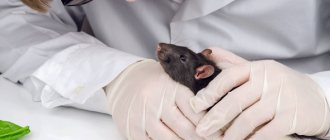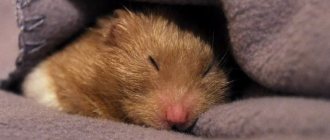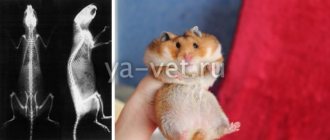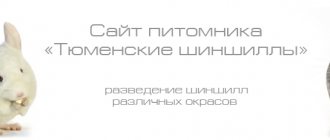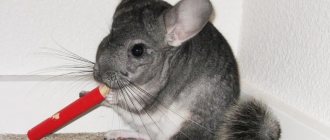In the wild, chinchillas live in mountainous areas, so they are well adapted to cool climates. However, colds can still occur in chinchillas at home. If the animal begins to sneeze, cough and has watery eyes or a runny nose, it is necessary to take it to the veterinarian for timely assistance. The doctor will understand the causes of the ailment and select the appropriate treatment.
Signs of ill health
You can suspect the presence of the disease based on the following signs:
- Change of behavior. The chinchilla becomes lethargic.
- Loss of appetite.
- Nasal or conjunctival discharge.
- Diarrhea.
- Dermatitis.
- Hair loss.
- Change in tooth color.
- Unpleasant odor from the mouth.
- Pathologies of the genital area.
Having noticed such symptoms, the owner is obliged to find out whether the conditions of detention, as well as the pet’s nutrition, comply with the recommended standards, and correct the detected deficiencies. The biology of a rodent is not comparable to that of a human, so trying to treat a chinchilla disease can do more harm than doing nothing.
It's sad to be sick
Endometritis
This is an inflammation of the uterus, which can develop either on its own or as a result of complications of cystic endometrial hyperplasia. You may not immediately pay attention to the symptoms, since the discharge of translucent fluid from the genital opening resembles discharge during estrus, with the only difference being that they do not last three to four days, but are permanent in nature and the amount of fluid increases. Sometimes the discharge is colored brown, yellow-gray, brown or green. Endometritis is likely due to the following behavior: lack of appetite with increased thirst, absence of pregnancy with correct and timely mating, constant refusal of the female to mate, and the birth of dead fetuses.
Heatstroke
Chinchillas lived in the wild in the highlands of South America. They are susceptible to drafts, but most of all to overheating. A temperature of 25 °C is critical for them. This should be taken into account by chinchilla farmers and animal lovers. The main symptoms of overheating are the following:
- Copious salivation.
- Diarrhea.
- Rolling to one side.
- Cramps.
Hyperthermia disrupts the functioning of chinchilla kidneys and myocardium. Without taking action, this condition ends in death. What should an owner do if a chinchilla gets sick before the veterinarian arrives? Transfer the animal to a dark, cool room and cover it with a cloth moistened with cool water. If the attack occurs on the street or in transport, the cage with the rodent must be moved to the shade: the chinchilla does not tolerate direct sunlight.
Respiratory diseases
Chinchillas may develop a runny nose or bronchopneumonia. The animals lack not only sweat glands, but also sebaceous glands. Therefore, chinchilla diseases occur under the influence of a draft, wetness; the animals catch cold easily, and their treatment begins with eliminating the cause.
Rhinitis
In chinchillas kept in an apartment, inflammation of the nasal passages is a consequence of drafts; those living in sheds can get sick due to hypothermia or sudden temperature changes. An allergic reaction to dust, including from excessively crushed feed, cannot be ruled out. The following symptoms occur:
- The nasal mucosa becomes inflamed.
- Breathing is difficult.
- The animal is depressed, rubbing its nose with its paws. He's shaking.
- Runny nose with copious nasal excreta.
- Tearing
- Hyperthermia >38 °C.
If production livestock gets sick, the sick are removed and the rest are treated. Sanitation of the premises with Chloride turpentine in the presence of animals is in demand. Treatment of chinchillas is carried out in courses lasting 5 days. After 2–3 days, the sanitation is repeated. If the need arises, the number of courses is increased to 8. If timely treatment is not carried out, the disease will spread to the underlying sections, bronchopneumonia will form and the animal will die. For preventive purposes, rodents are treated weekly.
At home, antiseptic solutions are dripped into the nose. Penicillin, tetracycline, and sulfonamides are effective. The course of treatment is not <5 days. In severe cases, intramuscular injections must be made.
Bronchopneumonia
If the animal develops wheezing, coughing, matted fur, or the temperature rises to 41°C, this indicates the occurrence of bronchopneumonia, so it is necessary to call a veterinarian who has experience working with ornamental rodents.
Otitis
Occurs in individuals with weakened immune systems or when exposed to drafts or changes in external temperatures. Characterized by rubbing the ears against the cage, scratching them. Pus may leak from the external passage and an unpleasant odor may be felt.
Exudate must be removed using an antiseptic lotion. Do not use warming compresses that create conditions for the proliferation of microflora.
Cough in rodents
Coughing in rodents can also be caused by various causes. They are presented:
- allergic reaction;
- heart failure. In addition to coughing, it is accompanied by wheezing and shortness of breath;
- tracheitis, pneumonia, bronchitis;
- foreign body in the larynx. The animal gags and attempts to cough up. In this case, you need to try to remove the stuck object yourself by turning the chinchilla upside down or take it to a doctor.
"Important! If suspicious symptoms appear, the owner needs to understand its causes, and for a more thorough diagnosis, it is better to show the rodent to a veterinarian.”
Eye diseases
Eye diseases in chinchillas can manifest themselves as an independent pathology and as a symptom of another illness, mainly respiratory. Additional symptoms besides lacrimation are:
- Cough.
- Nasal discharge.
- Depressed state.
- Labored breathing.
Tearing is detected by wet streaks on the rodent's cheeks. It is necessary to carefully consider the identified symptoms, take measures against the development of rhinitis and call a veterinarian. The most common eye diseases in chinchillas are:
- Conjunctivitis.
- Keratitis.
- Cataract.
Conjunctivitis
Inflammation of the conjunctiva in chinchillas can be primary or secondary. The former is caused by injury or irritation from solid or gaseous substances entering the eye. Secondary conjunctivitis occurs as symptoms of another disease.
Animals receive injuries as a result of fights or damage received during transplantation. It is significant that with conjunctivitis of infectious etiology, both eyes are affected, and with injuries, most often one. Getting dust or food particles into your eyes irritates them and causes watery eyes. If the cage is not cleaned, corrosive gases are released from the decomposing feces, which “cut” the eyes. Smoking in a room with a chinchilla can cause lacrimation in the sensitive animal.
Conjunctivitis is treated with eye drops. How to treat it at home").
Conjunctivitis
Keratitis
Develops from conjunctivitis. If not properly treated, serous discharges transform into mucous discharges, then purulent ones. The cornea is involved in the phlogistic process and keratitis develops. The animal is at risk of losing its sight.
Ulcers form. Treatment can stop the inflammatory process, but the defects become scarred and visual acuity decreases.
Cataract
The disease is characterized by loss of transparency of the lens. The ability to transmit light, and therefore to see, is lost. The cause of the pathology is unknown. There may be an innate predisposition to developing the disease. A cloudy lens in a pet is hard to miss. Highly qualified veterinary specialists have learned to perform lens replacement operations. There is a chance of restoring your pet's vision.
Cataract
Can chinchillas get worms from a cat?
If your chinchilla somehow became infected with worms, it was most likely from another animal in your home. One hypothetical scenario: You let your chinchilla roam freely around the house and he finds the litter tray.
But if your chinchilla is kept in a cage and never comes into contact with your indoor cat, there is no chance of worms being passed from one pet to another. The only potential carrier is you, for example if you pick up your cat's feces and then touch your chinchilla.
Anomalies of teeth
Healthy chinchillas, like nutrias, have bright orange-colored teeth. Dents subject to decalcification become pale yellow. The main reason is an imbalance in the diet in terms of minerals and vitamins or selective eating of certain ingredients by the chinchilla. The most reliable way to get rid of the disease is to use complete granulated feed. The animal is deprived of the opportunity to choose and consumes all the necessary substances.
Healthy teeth
An imbalance of nutrients provokes the development of a difficult-to-treat dental disease - drooling. It lies in the unevenness of dental growth. The animal has increased salivation, it scatters food and selects softer particles. Gradually, the nose and eyes become inflamed, and discharge forms from them.
Another pathology that causes significant concern to the chinchilla is hooks on the dents. This is a congenital disease characterized by the formation of malocclusion. Treatment boils down to grinding down the teeth with a drill using general anesthesia. You need to understand that sawed incisors grow back. After 6 months the operation must be repeated.
Sick teeth
Nutritional diseases
Diseases of chinchillas, characterized by an upset stomach, occur when feeding low-quality or improperly prepared food. Digestive disorders are caused by dusty or moldy hay or a sudden change in diet. Before giving the animal treats, you need to study the available literature, finding out what is possible, in what quantity, and what should be discarded. The best option is to feed industrially prepared granular feed. Farmers raising chinchillas, in order to reduce the cost of feed, can prepare it themselves by copying the recipe.
Healthy food for chinchillas
Most often, chinchillas experience the following diseases of the alimentary tract:
- Gastroenteritis.
- Flatulence.
- Constipation.
- Diarrhea.
Gastroenteritis
The disease is characterized by diarrhea that occurs as a result of feeding errors or as a symptom of another illness. Dysbacteriosis may develop as a result of uncontrolled use of antimicrobial agents. It is necessary to monitor the water; pathogenic microflora develops in it if it is rarely changed. The animal is advised to fast for one and a half days, boiled water, followed by feeding with pellets. As antidiarrheal agents, you can use astringents at home - oak bark, etc., or natural sorbents, for example, Smecta. The use of antimicrobial medications is carried out under the supervision of a veterinarian.
This food can harm your chinchilla
Constipation
The cause of the disease may be adynamia or overfeeding the animal with some kind of delicacy. In this case, fasting, the use of an enema or laxatives are indicated.
Flatulence
This disease occurs due to the fault of the rodent owner who fed him fresh or stale greens. The animals are depressed, lie motionless, the abdomen is swollen, and significant hypothermia is observed. The chinchilla is given sorbents and the stomach is massaged. It is better not to use antimicrobial agents without consulting a veterinarian.
Dacryocystitis
This is a violation of the outflow of tear fluid through the lacrimal canal due to inflammation of the latter. Owners often confuse this problem with conjunctivitis. But unlike the latter, with dacryocystitis the conjunctiva remains pink, without swelling, without film overlays. A cloudy white liquid accumulates and secretes at the inner corner of the eye, which provokes dermatitis and alopecia in the eye area. To eliminate the problem, a course of washing the lacrimal canal with weak solutions of antiseptic drugs is sufficient; in advanced cases, when secondary microflora accumulates, conjunctivitis, blepharitis and injury to the eyeball when scratching occurs.
Skin pathologies
The following types of skin diseases are distinguished in chinchillas:
- Lichen.
- Ectoparasites.
- Gnawing of fur.
Lichen
The biggest concern for the chinchilla and its owner is lichen. Humans are also susceptible to this fungal disease. Pathological fungi are ubiquitous, and under optimal housing and feeding conditions they do not cause disease. Warmth and dampness are required for their development. When kept in groups, the fungus, passing through many organisms, significantly increases its virulence, causing mass diseases. With lichen, itching, peeling of the skin, and the appearance of areas of baldness are observed. External antimycotics used in veterinary practice for treating small domestic animals are effective in treatment.
Ringworm on the ear
Along the way, they find out whether the animals are properly kept and fed. The shortcomings are eliminated. Perhaps the cause of dermatitis is not a fungus, but hypovitaminosis. Chinchilla breeders report that immunization with an anti-lichen vaccine helps with lichen. This fact has not received official confirmation, therefore, before conducting such experiments, you should consult a veterinarian.
Ectoparasites
The disease is characterized by itching, hair loss, and restlessness of the animal. Fleas come from other pets. Many insecticides that are harmless to other pets are toxic to rodents, so chinchilla breeders recommend bathing them in Bromocyclen solution and using flea collars for kittens and puppies. At the same time, owners need to take care of eliminating fleas in the apartment.
Gnawing fur
Chinchillas begin to chew out hairs due to an unbalanced diet, poor living conditions, or as a result of disruption of the functioning of the endocrine glands. Alopecia occurs throughout the body, damaging the skin. The situation can be corrected by switching chinchillas to professional balanced food. If isolated cases are identified, the sick ones are removed so that other animals do not follow their example.
Gnawed out her own fur
Can chinchillas get tapeworms?
Tapeworms are another type of worm; they don't look the same, but they do the same thing. They are flat and ribbon-like. Again, they do infect pets, but again, it is almost impossible for them to affect your chinchillas.
From a medical point of view, these worms are somewhat more dangerous than roundworms. This is because they can grow much larger. The larger the worm, the more it affects the digestive system of the host animal. While the host still absorbs most of the nutrients from its food, the worm takes a larger and larger share. Over time, this deficiency accumulates and the animal may lose weight.
There are also species found inside humans that could potentially be transmitted to pets. One particular species is known as the "rat tapeworm." It spreads when its eggs are ingested by insects and the animal eats the insect. The eggs can then be passed through the feces to begin the cycle again. Chinchillas can eat insects, although unless you hand feed them, it is unlikely that they will find and eat an infestation.
Urogenital diseases
The following pathologies are distinguished:
- Urolithiasis disease.
- Diseases of males.
- Pathologies of females.
Urolithiasis disease
The cause of the pathology is a cold, an unbalanced diet or the use of spoiled feed. Initially, cystitis develops, characterized by oliguria, the appearance of blood in the urine. If the inflammatory process has led to the formation of stones, urination is painful for the chinchilla. The animal staggers, it spins, whines, arches its back. Sulfonamides are used to suppress microflora that cause inflammation. If treatment does not help, fluoroscopy is performed and the stones are surgically removed or the chinchilla is culled.
Diseases of males
Males suffer from a lack of libido. Pathology occurs with poor feeding or excessive sexual activity. A ring of hair may form around the penis, preventing it from coming out completely. The fur formation is carefully removed. Sometimes the penis falls out of the preputial sheath. He's being adjusted. In both cases, males are prescribed increased feeding and two weeks of abstinence.
Ready to breed
Pathologies of females
The following pathologies may occur in chinchillas:
- Endometritis. Characterized by purulent dark-colored discharge. The female and male are separated and treated with antibiotics to prevent another chinchilla from becoming infected.
- Pyometra. A pet's uterus is removed.
- Urethral prolapse. Occurs during coitus. The operation is indicated.
- Difficult birth. The pet owner must understand that if the chinchilla is unable to whelp, a caesarean section will be required.
- Toxicosis of pregnancy. Appears when there are nutritional disorders, for example, overfeeding with treats. The prognosis is unfavorable.
- Abortion. They occur due to feeding disturbances, as well as rough handling by the chinchilla breeder.
Hair rings
They can form on the teeth and penis when wool is wound. It is observed in animals that refuse to bathe in sand or in the absence of these procedures. This is also a common occurrence in uncastrated males with increased sexual excitability. Tangled hair interferes with chewing or repositioning of the penis, depending on the location of the ring.
If a ring has formed on the penis, this leads to drying of the mucous membrane of the glans, swelling of the penis and often necrosis. It is necessary to periodically check animals for these insidious formations. In case of increased shedding, the animal should be combed with a soft brush with bristles (you cannot use metal brushes for dogs, cats, even with balls at the ends).

